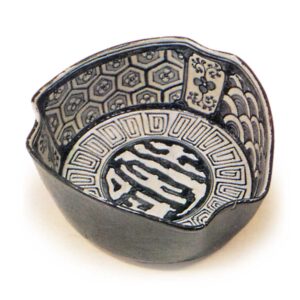
Porcelain from Tobe-cho, Iyo-gun, Ehime Prefecture. It is said to have originated in 1775, when Yasukazu Kato, lord of the Osu domain, ordered his retainer Saburobei Kato to build a kiln. Saburobei Kato supervised Josuke Sugino of Miyauchi, Haramachi Village, Iyo County (Miyauchi, Tobe Town), and invited five potters from Nagayo-yaki in the Omura Domain of Hizen Province (Nagasaki Prefecture) to build a kiln in Gobonmatsu Uehara, Tobe Village. Another theory is that Kadota Kinji of Tobe invested in the kiln and built it in the same year with Sugino Josuke as an engineer. In 1776 (5th year of the same year), Nobukichi, a potter from Kamisue in Chikuzen Province (Sue Town, Kasuya County, Fukuoka Prefecture), visited Tobe and told them that the failure was due to poor glaze stone and ash. This was the first Tomochi porcelain. This was the first Tobe porcelain. Josuke investigated glaze stones in the domain and found a good glaze stone in Kita-yamazaki, Iyo County (Miaki, Iyo City), which he used to start firing porcelain. Since whetstone shavings are poor raw materials for glaze, from around Bunka (1804-1888), he began to use magnets found at the bottom of the river in Kawato. The use of glaze stones from the Takano River and white porcelain stones from Takaboshi were discovered next, which further improved the quality. During the Bunkyu period (1861-64), the technique of dyeing was improved, and from the early Meiji period (1868-1912), fine white porcelain was also produced. In the early Meiji period (1868-1912), high-quality white porcelain began to be produced, and potters from Hizen were invited to Japan, and the Nishikite technique was introduced from Kyoto. Products of the time included Guanchu ten brocade, modeled after Chinese ten brocade, and pale celadon porcelain with a pale yellow tinge similar to Chinese Jianyao white porcelain. Master potters since the Tenmei period (1781-19) include Kido Kiyohachi (Tenmei), Mukai Genji (Bunka), Kanaoka Otozaemon (Bunsei), Toji Daizo (Kaei), Miyamoto Yuji (early Meiji), Ito Makoto (early Meiji), Mukai Wahei (early Meiji), and Kido Tokuzo (mid-Meiji).
During the Edo period, the kiln mainly produced underglaze blue ware, and also mass-produced iron-glazed tokkuri (sake cup). Currently, there are 33 kilns in the area, making it the most active ceramic production area in Shikoku.



